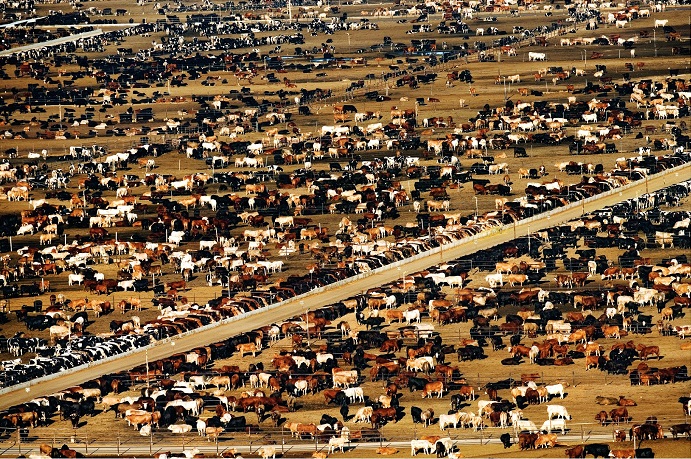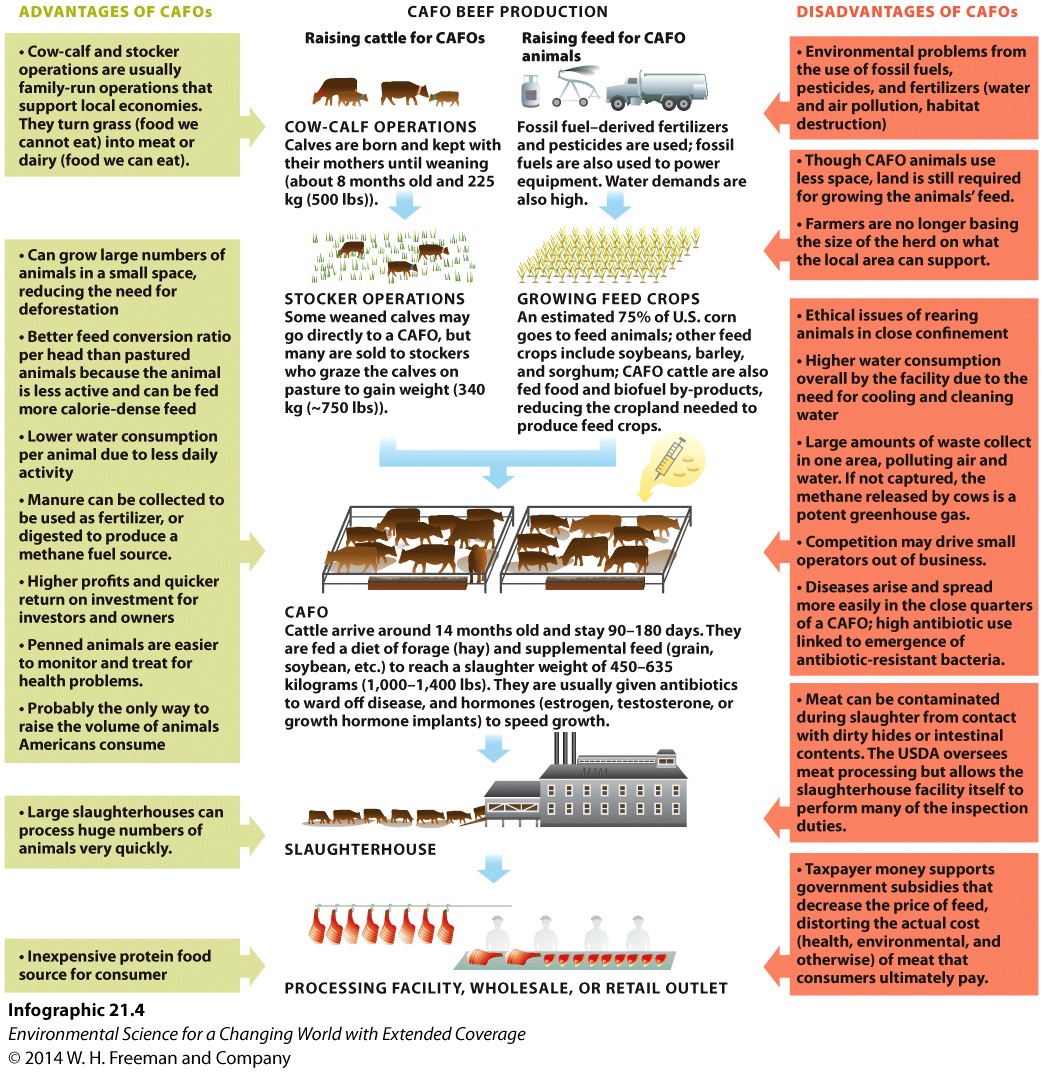
Chapter 21. Chapter 21: Agriculture: Raising Livestock
What methods do we currently use to grow animals for food...?

Guiding Question 21.3
What methods do we currently use to grow animals for food, and what are the advantages and disadvantages of each?
Why You Should Care
Concentrated Animal Feeding Operations (CAFOs) are the standard in beef production in the United States. They are the most efficient way known now to meet the consumer demand for meat products in the United States, and they greatly reduce the amount of land needed to raise cattle and provide jobs and livelihoods for many people. The drawbacks to CAFOs have already been enumerated, including antibiotic-resistant pathogenic bacteria and polluted and overused water supplies (both from the CAFOs themselves as well as from corn production). Although the methods differ somewhat for pork and chicken production, the use of corn-based feeds, overuse of water to deal with concentrated wastes, antibiotic use, and potential for environmental degradation are common to all three kinds of meat production. The alternative to concentrated, industrial-style meat production is the free-range, grass-fed approach. Cattle are grazed on grass throughout their entire lives; chickens and pigs are allowed to roam fairly freely and get a more varied diet. Manure becomes much less concentrated and usually does not need to be handled since it is removed by the local ecosystem. This and the less-concentrated growing conditions mean that animals can often be raised without the need for antibiotics. Growing meat animals with free access to the outdoors and without antibiotics or growth hormones are three of the conditions for certifying the meat as organic.
There are drawbacks to the free-range and organic methods as well, however. Although growers can charge more for organic meat, their production is less efficient than CAFOs, which reduces their profits. In fact, industrial methods can cut the time it takes for an animal to reach market size by almost half (though many would say this compromises the flavor). It takes more land to raise free-range cattle, but the land needed to grow corn for CAFOs offsets this difference. The bottom line is this: The best way available to grow all the meat demanded by U.S. consumers is to use CAFOs and similar methods, but the best way available to grow meat sustainably is to use free-range methods. Perhaps the demand for meat will lesson in the near future out of concerns for personal and environmental health, and free-range production will become more financially viable. Only time and your buying habits will tell.
1.
Which of the following is TRUE regarding feed conversion rates?
| A. |
| B. |
| C. |
| D. |
2.
Which of the following choices requires the LEAST amount of water to produce one pound of food?
| A. |
| B. |
| C. |
| D. |
3.
Which of the following is TRUE regarding “grass-fed” beef?
| A. |
| B. |
| C. |
| D. |
4.
Grass-fed beef is more sustainable than feed lot beef because:
| A. |
| B. |
| C. |
| D. |
5.
Order the following meat and dairy products from the most to the least amount of FOOD required to make one pound of meat or dairy product.
Most Food Required
Least Food Required
6.
Order the following meat and dairy products from the most to the least amount of WATER required to make one pound of meat or dairy product.
Most Water Required
Least Water Required
7.
Thought Question: Which product do you think is the most sustainable: beef, pork, chicken, eggs, or dairy? There could be more than one answer to this question, so make sure to explain your rationale.

Categorize the following statements as True or False:
8.
Cows are raised exclusively on corn.
False: Calves and their mothers are usually raised on grass or a combination of grass and grain until the calf is weaned and ready to be moved to a CAFO.
False: Calves and their mothers are usually raised on grass or a combination of grass and grain until the calf is weaned and ready to be moved to a CAFO.
9.
CAFOs support local economies and small-scale farmers.
True: Small-scale farmers are often the main suppliers of new cattle to CAFOs, which serve as a collection point for the cattle of many farms.
True: Small-scale farmers are often the main suppliers of new cattle to CAFOs, which serve as a collection point for the cattle of many farms.
10.
CAFOs both directly and indirectly reduce the pressure to clear forested land for agriculture.
False: While CAFOs themselves reduce the need to clear land for pasturing cattle, there is still a demand to provide more land for growing feed crops.
False: While CAFOs themselves reduce the need to clear land for pasturing cattle, there is still a demand to provide more land for growing feed crops.
11.
Grass-fed cattle produce more meat faster than CAFO cattle.
False. The feed conversion is much higher in CAFO cattle, meaning that cattle reach marketable size faster.
False. The feed conversion is much higher in CAFO cattle, meaning that cattle reach marketable size faster.
12.
CAFO cattle require less water than grass-fed cattle.
True. CAFO cattle are less active and therefore require less water, BUT more water per cow is used in a CAFO because of the extra water needed for cooling off cattle and washing out waste.
True. CAFO cattle are less active and therefore require less water, BUT more water per cow is used in a CAFO because of the extra water needed for cooling off cattle and washing out waste.
13.
Health problems in CAFO cattle are easier to detect and treat than in grass-fed cattle.
True. Being confined makes examination and treatment much more efficient, BUT close confinement is a cause of several health problems.
True. Being confined makes examination and treatment much more efficient, BUT close confinement is a cause of several health problems.
14.
CAFOs are most likely the best way to meet the current demand for beef in the United States.
True. Their efficiency makes CAFOs the best way to meet our meat needs.
True. Their efficiency makes CAFOs the best way to meet our meat needs.
15.
The price of CAFO beef accurately reflects the costs to produce it.
False: Government farm subsidies pay for much of the costs of producing CAFO meat, keeping its price to the consumer artificially low.
False: Government farm subsidies pay for much of the costs of producing CAFO meat, keeping its price to the consumer artificially low.
16.
Because of their lower operating costs, small grass-fed operations can offer their meat at prices competitive with those for CAFO meat.
False: Although overhead may sometimes be lower for grass-fed operations than for CAFOs, costs for CAFOs are subsidized. This means that grass-fed operations often cannot sell their product at as low a price as CAFOs can sell theirs, and it becomes harder for the small operations to make a profit and stay in business.
False: Although overhead may sometimes be lower for grass-fed operations than for CAFOs, costs for CAFOs are subsidized. This means that grass-fed operations often cannot sell their product at as low a price as CAFOs can sell theirs, and it becomes harder for the small operations to make a profit and stay in business.
17.
The release of greenhouse gases associated with CAFOs comes from the fossil fuels used for feed crop production.
False. It is true the that the fossil fuels used to operate machinery and produce fertilizers and pesticides are a major source of fossil fuel emissions related to CAFOs, BUT the large amounts of manure produced by CAFOs leads to the microbial production of methane, a potent greenhouse gas.
False. It is true the that the fossil fuels used to operate machinery and produce fertilizers and pesticides are a major source of fossil fuel emissions related to CAFOs, BUT the large amounts of manure produced by CAFOs leads to the microbial production of methane, a potent greenhouse gas.
18.
Some of the food used to raise CAFO cattle could have been used for human consumption.
True. While most of the corn and much of the soy and other grains raised in the United States is diverted from direct human consumption to feed livestock, some food sources could not otherwise be eaten by humans. These sources include pasture grass and other pasture plants and by-products from biofuel crops.
True. While most of the corn and much of the soy and other grains raised in the United States is diverted from direct human consumption to feed livestock, some food sources could not otherwise be eaten by humans. These sources include pasture grass and other pasture plants and by-products from biofuel crops.
19.
The factors that lead to rapid weight gains in CAFO cattle are restricted activity, high-calorie diets, and routine antibiotic use, which prevents food energy being diverted to the immune system.
False. CAFO cattle are also commonly treated with hormones, especially growth hormone, to increase their rate of growth. The use of restricted movement, antibiotics, and growth hormones are not allowed in organic meat production.
False. CAFO cattle are also commonly treated with hormones, especially growth hormone, to increase their rate of growth. The use of restricted movement, antibiotics, and growth hormones are not allowed in organic meat production.
20.
Thought Question: Some critics of the U.S. diet claim that the average person in the United States is made of corn, even if they never eat vegetables. What do they mean?
21.
Thought Question: Is CAFO meat really an inexpensive source of protein? Could there be even less-expensive sources?
Activity results are being submitted...